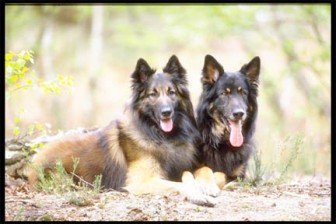Prolonged mating
We had mentioned that the actual act of canine intercourse is called the ‘tie.’ Some-times it can happen that the male and the bitch are ‘stuck’ for over an hour. This is not normal. You may recall (week before the last) that we made mention of the constricting vaginal rings (muscles) which help maintain the male’s erection. If the situation arises whereby there is no relaxation of the vaginal muscles, then the blood cannot flow back out of the engorged penis. The animals become anxious and frustrated and begin to pull against each other. This only serves to aggravate the situation.
So, what can you do? First of all, let me tell you what you must never do. Under no circumstance must you try to pull the dogs apart. In fact, you are best advised not to intervene at all. Do not throw water on them or try to coax them to separate. The best you can do, since they are unable to help themselves is to turn the male around so that he is again in the mounting position. You may then push downwards and forwards on his rump so that his penetration goes deeper into the vagina. This has the effect of relieving the constriction that is enveloping the penis via the muscular rings of the vaginal wall. It is then easier for the dogs to ‘decopulate’ and slide apart.
In passing, I would like to document an observation which could have some impact on our pets – before, during and after copulation; these comments have to do with the owner’s anxiety.

If you know that you are a person given to too much anxiety, then let someone else take your pet for the mating exercise. You stay inside the house and don’t even peek at the process of the tie. In fact, I would go so far as to say that it might be better for the dog of such an anxious owner to be taken away from its surroundings for the mating exercise. Dogs that live indoors, in constant and close companionship with their owners, will surely adopt some of the characteristics (especially fears) of its owner.

Sometimes, the behavioural patterns, nervousness and general propensity to worry impact seriously on the pets, even to the point of making them sick. I recall, long ago in my days as a young vet seeking experience, I was confronted with what seemed to be an incurable case of gingivitis (gum disease) in a poodle whose owner was a high-spirited lady of the night and whose partners were visiting the apartment at all hours with the concomitant neglect of the loving, sensitive pet. The moment the lady’s lifestyle changed after marriage, when both the husband and herself doted on the dog, the gum disease disappeared. I use this example to suggest how psychological disturbances can impact deeply on the behaviour of animals, even making them ill. Such effects can be also found in the area of reproductive efficiency.
Next week, we’ll look at the problem of extremely shy breeders – shy to the point that these animals will not mate. In fact, we might debate whether such reluctance, if genetically based, should be allowed to perpetuate itself in the next and future generations. In other words, should we assist such shy breeders to copulate and produce offspring?





